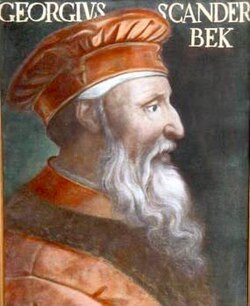Southeast Europe
The antemurale myth became an archetypal myth of nationhood in Southeastern Europe. [7] Nationalists developed narratives about their nations being Antemurale Christianitatis who protect the West from the invasion of Islam, while the West ungratefully forgets this fact. [8] Almost every nation in southeast Europe has perception and national myth of being bulwark of some universal system of values (Christianity, Islam,...). [9]
Albania

The Antemurale myth portrays Albanians as bulwark of civilisation and defenders of the religious tolerance in Europe and Balkans. Before Albanians were Islamized Antemurale myth presented Albanians as Antemurale Christianitatis. In Albanian nationalist myths Skanderbeg is a built-in part of the Antemurale myth complex which portrays Albanians united by Skanderbeg as protectors of the nation and Christendom against "invading Turks". [10] After the Ottoman Empire implemented Islam into Albania, there is another example of Antemurale myth. The ulama's depiction of predominantly Muslim Albanians as bulwark of more civilized, religiously tolerant and democratic, opposed to undemocratic Greeks and Serbs who remained Orthodox. [11]
Bosnia
The Bosnian Muslims (Bosniaks) were seen as a bulwark of Islam; the Ottoman frontier at Bosnia was perceived as the "Islamic border" toward the "enemy of the faith". When the Austrian army attacked Bosnia, Bosnian Muslims perceived their army as an "Islamic army" of "chosen soldiers" who "guard the Islamic borders". [12]
Croatia
Pope Leo X called Croatia the Antemurale Christianitatis in 1519, given that Croatian soldiers made significant contributions to the struggle against the Turks. The idea of defending the West against East was proven to be of crucial importance for definition of the Croatian self-identity. Croats are perceived as defenders of the western world against barbarous East. The first form of Antemurale concept was aimed against Ottoman Empire and later against Serbs who were portrayed as the "last of the barbarians" which are "trying to invade Europe". The territorial rights of Croatians to land within borders of Croatia inhabited by Serbs (Krajina) were justified by racial differentiation between Croats and those Serbs.[ dubious – discuss ] There were some attempts to ethnically separate Serbs living in Krajina from the rest of Serbs by claims that they were not of Slavic origin, but Vlachs who were settled in Croatia during the 16th century. [13]
The Croatian Antemurale myth was seen through perception of the Roman Catholicism and its position toward other religions, as described in the Nesting Orientalisms concept. Because Croats adopted Roman Catholicism, they are presented as peace-loving, honest, civilized, democratic and more European than Serbs because they adopted Orthodox Christianity, which is more Eastern than Catholicism according to the Nesting Orientalism concept. [14]
Serbia
The Antemurale myth is one of the most important Serbian myths [15] and has a very long tradition in historiography in Serbia and academic and political discourse portray Serbs as the defenders of Christian European civilisation. [16] The Antemurale myth in Serbia does not refer only to medieval history and events like the Battle of Kosovo where Serbs are portrayed as altruists who defend entire civilization of the west against attacks of Ottomans. The NATO bombing of Serbia in 1999 was interpreted through antemurale concept in which FR Yugoslavia heroically defended the world against US domination. [17]